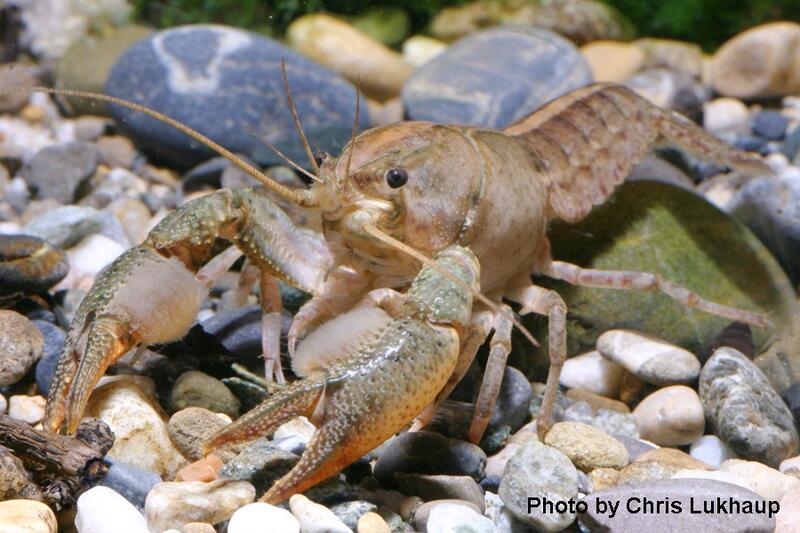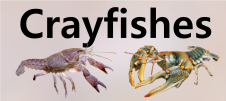







Loading profile. Please wait . . .
Procambarus barbatus (Faxon, 1890)
Wandering Crayfish




Federal Protection: No US federal protection
State Protection: No Georgia state protection
Global Rank: G5
State Rank: S5
Element Locations Tracked in Biotics: No
SWAP 2015 Species of Greatest Conservation Need (SGCN): No
SWAP 2025 Species of Greatest Conservation Need (SGCN): No
2025 SGCN Priority Tier: None
Element Occurrences (EOs) in Georgia: 0
Habitat Summary for element in Georgia: Open water of ditches and other temporary aquatic habitats and simple burrows in and adjacent to those habitats
The overall color of the Wandering Crayfish is tan to brown. Some specimens have a pale stripe down the entire length of the body while others lack this stripe and have more of a speckled appearance (Hobbs 1981). Striped individuals also have dark speckles on the carapace. The claws are brown with darker tubercles, and on adult males, there is usually a conspicuous brush of setae along the mesial margin of the palm. The areola is fairly wide and the rostrum gradually tapers and is rather spoon-shaped; there are no marginal spines or tubercles. This species reaches a maximum total body length of about 62 mm (2.5 in).
The combination of characters above should serve to separate the Wandering Crayfish from all others with which it might occur. Some individuals of the Ditch Fencing Crayfish, Faxonella clypeata have a pale stripe down the center of the body, but their movable finger is shorter than the mesial margin of the palm.
The Wandering Crayfish is considered a secondary burrower and is thus found in open water and simple burrows in ditches and other temporary aquatic habitats where the water table is near the surface of the ground. The burrows it constructs are typically simpler than those of primary burrowing species.
No studies of the Wandering Crayfish are known. Crayfishes are considered opportunistic omnivores and likely feed on live and decaying vegetation, aquatic insect larvae, small fishes, and dead animal matter.
Wandering Crayfish is considered a secondary burrower which means that individuals live in open water part of the time but retreat to burrows as water levels decrease. As with stream dwelling species, reproduction likely occurs during the spring and fall, but males in reproductive condition may be found at any time during the year. When female crayfish are ready to lay eggs, they usually find a secure hiding place and hence are rarely encountered. In the case of secondary burrowers, females probably use burrows when they release their eggs. After the eggs are released, the female attaches them to her swimmerets and is said to be “in berry.” Upon hatching, the juvenile crayfish are attached to the mother by a thread. After the juveniles molt for the second time, they are free of the mother, but stay close and will hold on to her for some time. Eventually they move off on their own. Crayfishes molt 6 or 7 times during their first year of life and most are probably able to reproduce by the end of that year. They molt once or twice a year for the remainder of their lives and live about 3 years. Male Wandering Crayfish in reproductive condition have been collected in all months except July, October, and November. Eight females carrying eggs were found in April, 4 in May, and 1 in June (Hobbs 1981). The smallest breeding male known is about 36 mm (1.4 in) and the smallest female with eggs is about 36 mm as well (Hobbs 1981).
Burrowing crayfishes may be collected by direct excavation of their burrows, by trapping, and during night surveys. Excavating burrows is time consuming and can be very difficult. It also results in destruction of the animals’ burrow. Traps made with PVC pipes or mist nets can be effective. Burrowing crayfishes are sometimes captured around the openings of their burrows on damp nights. Active burrows are typically found from about mid-March to mid-November if the water table is within about two feet of the surface of the ground. When rains fill the temporary habitats with which this species associates, and the mouths of their burrows are inundated, they may be caught by seining or dipnetting (Hobbs 1981).
The Wandering Crayfish is found in southeastern Georgia between the Altamaha and Savannah rivers, and in South Carolina between the Savannah and Edisto rivers (Hobbs 1981). It is also widespread on Sapelo Island (C. Skelton, unpubl. data).
Activities that destroy temporary aquatic habitats or alter hydrology in the vicinity of burrows threaten this species.
This species is common and widespread and therefore is considered stable.
General watershed level protection measures will help secure the continued existence of the Wandering Crayfish crayfish in Georgia. These include the protection of riparian zones, control of sediment and nutrient runoff from farms and construction sites, and limiting the amount of impervious cover (e.g., pavement) within occupied watersheds. Non-native crayfishes should never be used for bait. Instead, anglers should use crayfishes collected from the river system they will be fishing in and should never release unused bait crayfish back into Georgia waters.
Hobbs, H.H., Jr. 1981. The crayfishes of Georgia. Smithsonian Contributions to Zoology 318:1–549.
Taylor, C.A., G.A. Schuster, J.E. Cooper, R.J. DiStefano, A.G. Eversole, P. Hamr, H.H. Hobbs III, H.W. Robison, C.E. Skelton, and R.F. Thoma. 2007. A reassessment of the conservation status of crayfishes of the United States and Canada after 10+ years of increased awareness. Fisheries 32:372–389.
Christopher E. Skelton
C. Skelton, August 2012: original account
C. Skelton, March 2019: general update of account.
D.Weiler, September 2019: photo added